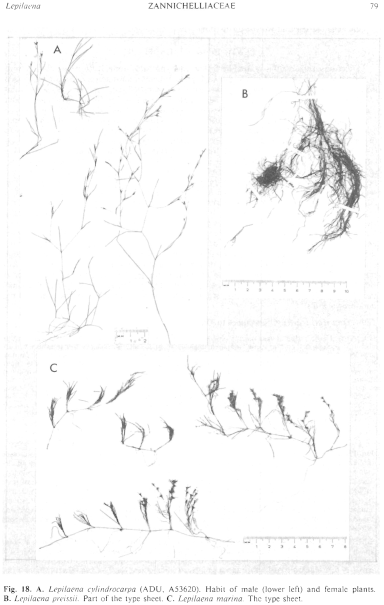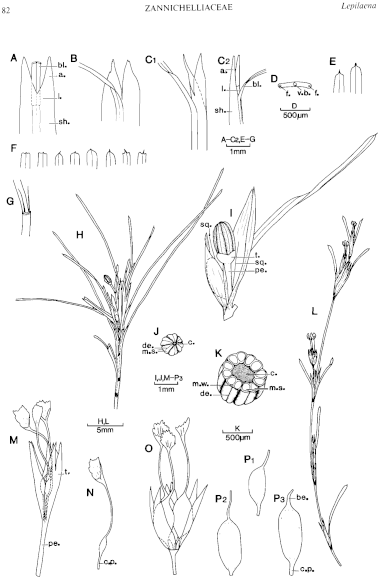|
|
|
|
|
|||||||||||
|
Electronic Flora of South Australia Species Fact Sheet
Phylum Magnoliophyta – Subphylum Seagrasses – Class Liliopsida – Subclass Alismatidae – Order Potamogetonales – Family Zannichelliaceae
Dioecious; rhizomatous marine herb (Fig. 18C), probably annual. Rhizomes about 1 mm in diameter, much-branched, bearing at each node a membranous amplexicaul scale 3–5 mm long, and at usually every alternate node 1–4 (–5) unbranched roots and an erect leafy shoot (2–) 3–5 (–10) cm tall. Leaf sheath (Fig. 20A–C) membranous, 4–5 (–10) mm long, ligule about 2 mm long, usually deeply cleft so as to appear bi-auriculate; blade (Fig. 20D) linear, (1–) 2–3 (–5) cm long, (0.2–) 0.3–0.4 (–0.5) mm broad, entire, in cross section showing a median vascular bundle and marginal fibre strands; apex (Fig. 20E, F) usually truncate with a central mucro (but considerable variation in apex shape can occur on the one plant -Fig. 20F). Squamules (Fig. 20G) filiform, about 1 mm long. Male flowers (Fig. 20H–K) in densely leafy shoots 3–5 (–10) cm tall; axillary, subtending leaves scarcely if at all modified; arising singly in a series of successive leaf axils with only 1 (rarely 2) mature at a time; shortly pedicellate at first, pedicel elongating and becoming filiform and 1–1.5 cm long at anthesis; tepals 3, minute; stamen with 6 pollen sacs, 1.0–2.5 mm long, connective not extended. Female flowers (Fig. 20L–N) borne on slender erect leafy shoots 5–10 (–25) cm tall, frequently projecting above the vegetative shoots; each flower axillary, borne on a short pedicel 1–2 (–5) mm long, usually closely adpressed to the axis with the flower extending well beyond the leaf sheath, subtending leaves reduced and sub-opposite; tepals (1.5–) 2.5–3 (–3.5) mm long, membranous, elliptic, apex mostly deeply bifid and somewhat dentate; carpophore up to 1 mm long; styles projecting the stigmas well beyond the tepals; stigmas obliquely funnel-shaped with an irregularly dentate margin. Fruit (Fig. 20 0,P) an achene, dark-brown, asymmetric oblong, (1.1–) 1.3–1.7 (–2.0) mm long, L/B 1.5–2 (–2.5), shorter than or equal to the tepals, smooth with a slight dorsal ridge, carpophore not elongated, fruits enclosed within the tepals with only stylar remains projecting. Tepals frequently becoming scarious and whitish and very conspicuous around the dark-brown fruits.
Type: Type locality: Port Clinton, Yorke Peninsula, S. Aust., mid eulittoral. (Robertson, 18.xi.1981 ). Growing with Zostera mucronata and Ruppia tuberosa.
Holotype: ADU, A52656. Isotypes in AD, MEL, PERTH.
Selected specimens: The type and Tulka, Proper Bay, Port Lincoln, S. Aust., low eulittoral (Womersley, 21.viii.1967; ADU, A46522). Eastern flats, American River inlet, Kangaroo I., S. Aust., mid eulittoral ( Womersley, 26.viii.1948; ADU, A46521). Barker Rocks, Yorke Peninsula, S. Aust., sandy platform on mid eulittoral flats (Robertson, 15.xi.1981; ADU, A52723). Coobowie Bay, Yorke Peninsula, S. Aust., mid eulittoral (Robertson, 18.ix.1981; ADU, A52652). Coobowie inlet, S. Aust., uppermost sublittoral, 0.5 m deep (Robertson, 2.x.1982; ADU, A53653). Port Gawler, S. Aust., mid eulittoral (Robertson, 16.xii.1981; ADU, A52793). Swan Bay, Queenscliff, Vic. (King, 17.ix.1969; MELU, 4682 and MEL, 103509). Boomer, Blackmans Bay, Tas., in tidal water (Curtis, 1.xi.1947; HO, 58750).
Distribution: From Sceale Bay, Eyre Peninsula, S. Aust. eastwards to Port Phillip Bay, Victoria, on Bass Strait Islands and Boomer, Blackmans Bay, Tas. L. marina forms extensive low turfs in mid and lower eulittoral zones on sandy mud tidal flats, growing in association with Ruppia tuberosa and Zostera mucronata in S. Aust. (Pl. 16, fig. 5) or with Zostera muelleri in Vic. and Tas. It also occurs just subtidally in some localities.
Taxonomic notes: The fruit of L. marina is very similar in shape and proportions to L. preissii. However, L. marina is clearly distinguished from L. preissii by its consistently dioecious character, the densely leafy branches bearing the male flowers, and its broader leaf blade with a more truncate apex.
References: The Marine Benthic Flora of Southern Australia Part I
Publication:
Womersley, H.B.S. (31 May, 1984)
The Marine Benthic Flora of Southern Australia
Part I
©Board of the Botanic Gardens and State Herbarium, Government of South Australia
Illustrations in Womersley Part I, 1984: PLATE 16 fig. 5; FIGS 18C, 20.

Plate 16 enlarge
PLATE 16 Fig. 1. Posidonia sp. (probably P. angustifolia) and Amphibolis antarctica. Off Seacliff, Adelaide, S. Aust., 5 m deep. (Photo by J.E. Johnson.)
Fig. 2. Posidonia balls (close up). Middleton beach, near Port Elliot, S. Aust. (Photo by E.M. Wollaston.)
Fig. 3. Posidonia balls. Middleton beach, near Port Elliot, S. Aust. (Photo by E.M. Wollaston.)
Fig. 4. Heterozostera tasmanica and Halophila australis community. Carcase Rock, off Eyre Peninsula, S. Aust., 6 m deep; (34°44'S, 136°05'E.). (Photo by S.A. Shepherd.)
Fig. 5. Zostera mucronata with Lepilaena marina and Ruppia tuberosa in foreground, and mangrove seedlings in the background. Mid eulittoral tidal flats, Port Clinton, S. Aust. (Photo by E.L. Robertson.)

Figure 18 enlarge
Fig. 18. A. Lepilaena cylindrocarpa (ADU, A53620). Habit of male (lower left) and female plants. B. Lepilaena preissii. Part of the type sheet. C. Lepilaena marina. The type sheet.

Figure 20 enlarge
Fig. 20 Lepilaena marina. A. Portion of leaf (adaxial view). Junction of blade (bL) and sheath (sh.) opened out showing ligule (L) deeply bifid into 2 auricles (a.). B. Junction of blade and sheath opened out (abaxial view). C1, C2. Junction of leaf blade (bl.) and sheath (sh.) (side view). D. T.S. leaf blade showing median vascular bundle (v.b.) and marginal fibre strands (f). E. Leaf apices (juvenile). F. Leaf apex variation (mature leaves). G. Squamules in position at node (subtending leaves removed). H. Male inflorescence showing mature male flower on elongated pedicel releasing pollen, and young male flower enclosed in sheath. I. Two male flowers before anthesis, one enclosed in sheath. Note tepals (t.), pedicel (pe.) and squamules (sq.). J. Male flower from above showing connective (c.), 12 microsporangia (m.s.) and line of dehiscence (de.). K. T.S. through a young male flower showing connective (c.) and 6 pollen sacs each with a pair of microsporangia (m.s.) Note line of dehiscence (co.) and wall (m.w.) between a pair of microsporangia which breaks down at maturity to leave a 6- loculed structure. L. Female inflorescence. M. Female flower on pedicel (pe.) showing tepals (l.) enclosing 3 carpels with styles projecting. N. Single carpel removed from tepals. Note carpophore (c.p.). 0. Mature fruit showing achenes enclosed within tepals. P1-P3. Achenes showing carpophore (c.p.). and stylar beak (he.). (A–G, I–K, M–P from the type. H, L from ADU, A52793.)

|
Email Contact: State Herbarium of South Australia |

|